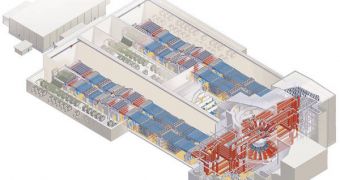Recreating the conditions that exist within the Sun has been a long-term desire for physicists, and it would appear that scientists in the US are very close to finally fulfilling this dream. The country's National Ignition Facility (NIF) is, according to officials, operational and ready for action. The device is located at the Lawrence Livermore National Laboratory, in Livermore, California, and is, in fact, a laser-based inertial confinement fusion (ICF) research facility. Scientists hope it has the ability to compress small amounts of hydrogen fuel to the point where nuclear fusion is obtained.
Nuclear fusion is one of the main goals of scientific research today, for the simple reason that it relies on a very cheap fuel (heavy water that can be obtained from seawater) to create virtually limitless amounts of electricity, with zero-emissions. If a power plant based on nuclear fusion could be constructed, then the technology would soon make all other forms of electricity production obsolete. The amount of energy produced by a fusion engine could potentially propel spacecraft to enormous distances, and faster than ion thrusters do today.
With all these stakes, it stands to reason that everyone at the NIF is excited about the upcoming ignition of the research device. It is the largest research facility in the US, and has taken more than 12 years to build from scratch. It works by focusing the light from 192 gigantic laser beams onto a small hydrogen pellet, with the purpose of obtaining temperatures that are high enough to initiate and sustain nuclear fusion. For the experiments to be deemed successful, the facility has to put less energy into jump-starting fusion than the amount that comes out of the process.
Experiments at the NIF will begin this June at the earliest, and concrete results are expected to be available for publishing anywhere between 2010 and 2012. “This is a major milestone. We are well on our way to achieving what we set out to do – controlled, sustained nuclear fusion and energy gain for the first time ever in a laboratory setting. We have an incredible amount to do and an incredible amount to learn,” the Director of the facility, Dr. Ed Moses, explains.
If the experiment succeeds, then the accomplishment would be a “seismic event,” the leader of a similar European venture, Professor Mike Dunne, says. “It would mark the transition for laser fusion from 'physics' to 'engineering reality.' We are now very close to the culmination of 50 years' effort. The world is looking to NIF to provide a clear, unequivocal demonstration that lasers can initiate fusion energy gain,” he adds for the BBC News.
“The technology of NIF allows the laser to fire every few hours. This is right for the demonstration of the physics 'proof of principle,' but does not meet the requirement of a laser fusion power plant, which needs to operate a few times per second. This means a fundamentally different laser technology, a new approach to fuel pellet production, and a suite for robotic handling capability. We are entering a period when much of the technology development is common to both approaches. We believe that the two-track approach is essential given the scale of the problem, and the predicted impact on society,” Dunne concludes.

 14 DAY TRIAL //
14 DAY TRIAL //